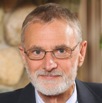By Ken Camp
Social media may link people across the globe, while at the same time segmenting them generationally, one of American’s foremost scholars on technology and the church told an April 29 gathering at Baylor University’s George W. Truett Theological Seminary.
“It’s increasingly easy to communicate across geographic space and increasingly difficult to communicate across generations,” Quentin Schultze, chair of the DeVos Communication Center at Calvin College, said at the symposium titled “iFaith? The Church in the Digital Age.”
 As a result, he said, those people conversant with newer technologies are often segregated from the wisdom of the ages.
As a result, he said, those people conversant with newer technologies are often segregated from the wisdom of the ages.
Ironically, he noted, congregations that adopt projection technology in sanctuaries over the objections of older members believing it will attract younger worshippers often discover they miss the mark.
“After a while, the older members most appreciate the user-friendly technology, and the youth see it as cheesy,” he said.
Schultze said practically everyone feels over-messaged, and that communication overload can create a “cultural ADD” and shallow understanding of other people. “Biblical friendship requires time and proximity, even in a digital age,” he said.
He said easy access to alternative viewpoints via digital media contribute to “intellectual skepticism and cultural agnosticism,” because when media present multiple versions of “truth,” people tend to withhold judgment on propositional claims and trust more in feelings and personal experience.
In light of that context, Schultze urged church leaders to focus on four timeless practices: listening, authenticity, hospitality and leisure.
“Listening means attending to reality,” he said. “It is the ground for all good, loving communication.”
Schultze said in a digital culture where many assume artificial personas and concentrate on creating an image, young people particularly are attracted to adults who are real and who admit their own faults and doubts.
While digital-based communities generally develop around what people have in common, Schultze said churches can model intergenerational life together with people who have varied perspectives and come from all walks of life. “Make room in our hearts and minds for those who are different,” he advised.
Also, in a digital age of almost-omnipresent mobile devices, he said people need Sabbath rest and a respite from incessant messaging.
A responder to Schultze’s address, Chris Seay, pastor of Ecclesia in Houston, an emergent church that incorporates ancient liturgy and modern media into worship, said nearly any technology can be an effective tool, but no church should become enthralled by it.
“If it’s about being cool or uncool, the line for cool keeps moving,” he quipped.
A key question churches should ask is whether any technological tool enhances or inhibits its ability to touch lives. “A potential pitfall is the belief you can relate to people without having to touch them,” Seay said.
While technology can create distance, it also can draw people closer, he noted. For example, his church shows video from mission projects around the world that the congregation helps support. Video can help members who may never travel abroad feel more closely connected to global ministries and the people whose lives are touched by them.
Seay said technology should serve a purpose, not call attention to itself. “When you use technology well, it becomes invisible,” Seay said.
Doug Henry, professor in the Great Texts program at Baylor University, echoed that theme. He suggested that as churches evaluate the use of any type of technology in worship, they should ask whether it serves as an icon that draws attention to the divine or a spectacle that draws attention to itself.
“An icon is translucent to the light of God. A spectacle is opaque to the light of God,” he explained.
The program was co-sponsored by Baylor’s Center for Ministry Effectiveness and Educational Leadership and the Kyle Lake Center for Effective Preaching.
“There is a growing tension today between the traditional face-to-face communication and interaction within the church and the now almost-universal mediating presence of technology – whether computers, smart phones, iPads, interactive television, PowerPoint and the like,” said Donald Schmeltekopf, provost emeritus and director of the Center for Ministry Effectiveness and Educational Leadership.
The Kyle Lake Center for Effective Preaching is named for a 1997 Truett Seminary graduate who died while serving as pastor at Waco’s University Baptist Church. His parents, David and Shirley Lake, helped establish the center to honor their son’s dynamic and creative preaching ministry and so that his influence will continue for generations to come.
— Baylor University’s Terry Goodrich contributed to this report.
